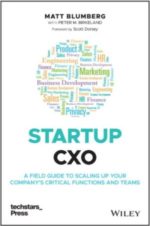Good Question – How's the Blog Working Out So Far?
My dad, one of the smartest people I know, asked me a good question last week. “How’s the blog working out so far?”
My answer was generally “I’m not sure,” but as I thought about it more, I saw “good” coming from four different categories, in order of importance to me:
Thinking: One of the best things publishing a blog has done has been to force me to spend a few minutes here and there thinking about issues I encounter in a more structured way and crystallizing my point of view on them. Invaluable, but mostly for me.
Employees: A number of my employees read it, although I’m not exactly sure who since RSS is anonymous. I know this is helpful in that some of the folks in the company who I don’t speak with every day can hear more directly some of the things I’m thinking about instead of getting a filtered view from normal communication channels.
Technology: One of the main reasons I started the blog was to get more experience with blog/alert/publishing/RSS tools as I try to learn more about new technologies related to my company. This has paid off for me well so far (the technology has a long way to go!).
Business development: I have met two or three other companies who may be potential partners for Return Path through this. I also believe that the postings on industry-related topics have been helpful for both business development and PR purposes.
I promised my Dad I’d do a posting on this sometime soon…so happy Father’s Day, Pops! (I also got him a real present, don’t worry.)
Breaking Up is Hard to Do
Fred Wilson has a great posting today about how as a VC, it’s important to tell CEOs the truth when you don’t fund them so they can learn from the experience. As someone who’s been dinged by his share of VC’s (although not yet by Fred), I completely agree. He drew a great comparison to a conversation he had with a woman on an airplane about telling someone she didn’t want to go on a second date with him.
I’ve always felt that as a manager, firing someone is a lot like breaking up with a significant other. As the song says, Breaking Up is Hard to Do! This is particularly true when the person is either a long-time employee or is someone you have to lay-off, where the termination is not his or her fault.
When I think back to the first time I ever had to fire a person while I was at MovieFone, I remember it as one of the most horrific experiences of my life. Not to be glib about it, but I think it was harder on me than it was on her (and it was a lay-up – she was being fired for cause!).
Anyway, for an empathetic person, it is hard to look people in the eye and tell them they don’t have a job any more, whatever the reason. And I also think that people are generally well-served, even if they don’t think about it that way at the time, if they can understand why they’re being let go so they can continue to constructively develop their careers going forward and seek out jobs for which they might be a better fit.
Of course, in a non-layoff situation, someone being terminated should know why they’re being fired because a good manager would have coached them and given them appropriate warnings and conversations along the way, but that’s the subject of another posting.
FTC on Email – Missing the Point
Today, the FTC very shrewdly punted on the issue of the proposed “Do Not Email” list implementation, saying that authentication systems need to be put in place before such a list can be considered. This buys the world more time to work on more effective, market-driven solutions to the spam and false positive problems.
I read a few interesting posts on this today, including one from Jeff Nolan which nicely captured Chuck Schumer’s elegant combination of demagoguery and idiocy about this issue; and one from Anne Mitchell pointing out that they’re about six months late with their conclusion. Feels about right for the federal government.
What’s interesting to me is that all of the comments by and about the FTC and the proposed “Do Not Email” list focus on the wrong thing: they say that the problem with the list is that spammers would abuse it by hacking into it and stealing all the email addresses. Ok, I’ll admit, that’s one theoretical problem, but it’s not THE problem.
The structural problem with a national “Do Not Email” list is that responsible emailers, non-spammers, don’t need to use it since they get appropriate permission from their customers before sending them email…and spammers won’t bother using it since they don’t give a hoot anyway and will find a way around the list as they do everything else. In the end, the creation of such a list would do nothing to stop spam, but it would certainly create a lot of confusion for legitimate marketers and their customers around opting in and opting out. It would also, notably unlike the fairly successful national “Do Not Call” list, not do anything to reduce the volume of spam, which will create disappointment and anger among consumers (and hello, Senator Schumer, backfire on its political sponsors).
Those aren’t bigger problems than spam to be sure, but why should we implement a solution to the problem that doesn’t work at all and that causes its own ancillary problems along the way?
CEO, Party of Two
We spent the weekend in Hudson, New York, a charming, urban-renewing town about two hours north of the city. My cousins Michael & Marianne opened a wine store called Hudson Wine Merchants on the main drag in town, Warren Street (343 Warren St. to be exact, you should definitely check it out if you’re ever in Hudson).
The store opened for the first time Friday evening, and we had the first full day on Saturday. Mariquita and I, and some other friends of Michael & Marianne’s, helped do everything from stock the shelves, to clean the windows, to use the price tag gun (fun!), to work the register and the very fickle POS software, to watch my cousin’s daughter as she rode her tricycle through the store. It was fun but exhausting. It inspired a few different postings here, which I’ll work on in the coming days.
The first thought I had is that being CEO of a two-person company has a lot in common with being CEO of a 200-person company, or, I imagine, a 20,000-person company:
– You worry incessantly about keeping your customers happy and providing a great customer experience and the right product
– You have numbers running in the back of your head all the time. How much are you selling? At what margin? Are you making money?
– You work your ass off and frequently put business first in order to see it succeed
– You think about the little things, the big things, everything, 24 hours a day
Obviously, there are many differences between running a two-person company and running a much larger organization as well; of course, the biggest is managing, developing, and worrying about lots of employees’ welfare. But it struck me that there are more similarities than meet the eye.
Gmail – I Don’t Get It
I honestly don’t get all the buzz about Gmail, Google’s new email service. I took a look at it today to see what the the big deal was.
It’s got a few features which are marginally better than other webmail services, but not too many and not massively better. The free storage is not a big issue for most users, although it may cause a few power users to switch over. The most interesting feature in my mind is the ability to use Google Search on your own email file, which is very useful.
All in all, it’s a good product, but all these people talking about how 30mm people are going to switch over to it must be seeing something I don’t. My prediction (and I’ll happily and publicly acknowledge defeat if I am misreading this) is that they will get a few million new users initially, many for a second or third address as opposed to their primary address, and that many of them won’t stick with it to become active users over a longer period of time. After that, they’ll grow at the same rate, with the same type of characteristics, as Yahoo, Hotmail, and other webmail providers.
Email and email addresses, unlike search engines, are pretty sticky things.
Lessons from the Gipper
There’s been much coverage in the news of Saturday’s passing of President Ronald Reagan, but I will add a new wrinkle by trying to distill down what I know and remember of The Great Communicator’s leadership style into a few simple lessons of note for CEOs.
Lesson 1: Sunny optimism motivates the people you lead, but only when it’s balanced with hard-headed realism. Reagan’s message that tomorrow can be a better day than today was powerful and timely for the American psyche, but he didn’t just assume that because he said it, it would be true. He backed up his message with (a) an understanding that the American economy itself was in the doldrums in the late ’70s, and (b) policies designed to fix the economy. Whether you agree with those policies or not, you have to respect the fact that Reagan as a leader wasn’t just talk — he combined the talk with reality-based action. That’s super important when communicating key messages to a company of any size.
Lesson 2: Simplicity of messaging beats out measured intellectualism in broad-based communications. Reagan’s view of the 40-year-old Cold War when he took office was “we will win, and they will lose.” Much easier to rally around than messages of detente and containment (this quote came from an editorial by former Reagan staffer Peter Robinson in today’s Wall St. Journal). Similarly, the bigger and more diverse the group you’re talking to inside your company or in a speech or in the press, the more important it is to boil your key message down to something people can easily take away with them and repeat at home later to their spouse or friends.
Lesson 3: Nobody’s perfect, and you don’t have to be perfect either. He may have been, electorally, the most popular president of our generation, but Reagan certainly had his many and sometimes glaring faults. History will acknowledge his faults but overall judge him on his performance. It was noted (also in today’s Journal, I think) that Reagan got a lot of little things wrong, but in the end, he will be remembered because he got a few big things very, very right. Perfection is something that most mortals can’t achieve, certainly not in a high profile position like President or CEO of anything, whether a 10-person startup or a nation.
Love him or hate him, the man was one of the most prominent leaders of our time. I’m sure there are more lessons from Reagan’s legacy than these three for CEOs, but this is a start, anyway.
Anything Worth Doing is Worth Doing Well
I was reminded again today of this very simple but important principle in two separate instances with people on the team here at Return Path. I’ll describe them anonymously here, as I always will when I discuss things that happen at my company.
In one case, someone sent a document out to a prospect that was not “client-ready.” It had all the right content, but it was poorly formatted, not as well-organized as it could have been, had a couple of typos, and wasn’t on our company template. My colleague’s comment: “it got the job done, didn’t it?” My response: “it doesn’t matter — it didn’t look world class.”
In another case, someone had a relatively minor task to do, which was to turn some collateral and press clippings into a wall display for our office. It was something that could easily have been postponed or done in a half-assed way, but my colleague went to extra lengths to make sure it looked perfect and made our lobby area look very professional.
There is, of course, the 80/20 rule to keep in mind (that’s probably the subject of another posting), but for the most part, I’m a big believer in the axiom that anything worth doing is worth doing well.
Prepping RSS for Prime Time
With all the hype in the world of blogs in the past few months about RSS taking over the world, I’ve been getting myself up to speed on the space by meeting with some of the companies in it and by publishing my own blog here.
Two of the CEO’s I’ve met with in the RSS business are super smart and are doing everything they can to get the technology ready for prime time. What do I mean by that? I mean:
Critical Mass: 10 million or more end users using RSS, not just the tech/finance/journalist axis that dominates usership today. Hundreds of mainstream publishers and marketers using RSS, not just a handful of businesses and loads of individuals or small sites.
Ease of Use: Easy to get in the game as a consumer, easy to publish as a business. It is called Really Simple Syndication, after all, and it’s not even close yet, either in terms of technology or awareness.
Organization: Making sure RSS doesn’t quickly fall into the “information overload” bucket as the number of publishers proliferates and as the number of hours in people’s day remains constant.
Multi-Channel: Making it work with other channels the same way email has come to work with direct mail and banners have come to work with brand advertising.
Presentation: Giving publishers greater control over exactly how end users see feeds.
Revenue: Whether it’s ads in feeds, driving people to web sites, subscription revenue, or something else, the world has to figure out how RSS will contribute to the bottom line for it to be commercially viable.
Accountability: Good stats, reporting, and tracking. A pay-to-play function for marketers who use addressable media.
It will be interesting to see how this space unfolds, but my money’s on Dick Costolo of Feedburner, and Greg Reinacker of Newsgator, to be two of the pioneers who figure it all out.
Why Blog?
There was a good piece in the New York Times yesterday about blogging, including some good quotes from Jarvis.
I’m getting the hang of it, but I have to say that blogging in the bathroom is taking things a little bit too far.
SPF and Caller ID for Email Merge – What Does This Mean?
Yesterday’s announcement that Microsoft is going to merge its nascent Caller ID for Email authentication standard with the more populist Sender Policy Framework (SPF) is an interesting development in the war on spam.
But what does it really mean?
It means that sender authentication is headed towards a standard. Where once there were three, now there are two (Yahoo Domain Keys is another standard, although it’s still a little unclear whether it’s competitive or complementary).
Authentication is an important component of the war on spam because it allows ISPs and other email receiveing servers to verify that the sender of the email is who he says he is. Spammers don’t do that.
But authentication is only one facet to the war on spam. The others, at least the way we see them at Return Path, are (in no particular order):
Reputation: Proving you, as a mailer, are a good guy. Low complaints, good email capture policies, working unsubscribe, proper server configuration, and a host of other components.
Monitoring: Understanding how your mailings fare in the real world. Are you being blocked? Filtered? Blacklisted? Greylisted? When? Where? By whom? And most important, why?
Best Practices: Making sure you’re doing things the right way as an emailer, attacking the root causes of complaints and blocking, creating email programs that not only work economically, but work socially as well.
Payment: Ultimately, although I’m not sure what form it will take, someone will have to eliminate the economic free ride problem that created spam in the first place. Translation: mailers will probably have to pay something, to someone, to guarantee delivery.
Popular Misconceptions About Bonded Sender
There have been many postings about Microsoft’s recent announcement to use Ironport’s Bonded Sender Program as one of its many tools to fight spam and reduce false positives. I won’t belabor them here, but there are three common misconceptions I’m reading on the web and in blogs that I thought I’d point out and try to clarify.
Misconception #1: Bonded Sender is a Microsoft product, and Microsoft will profit from it. Why it’s not true: Bonded Sender is operated by Ironport, Inc., a completely separate company from Microsoft. Bonded Sender and its cousin, Sender Base, are used by over 20,000 domains. Microsoft is just the latest, and highest profile, user. I don’t believe that Microsoft is making any money from their use of Bonded Sender, but at a minimum, it’s not their product.
Misconception #2: With Bonded Sender, spammers can now buy their way into your inbox. Why it’s not true: While the premise behind Bonded Sender is that commercial emailers should put their money where their mouth is and have a financial penalty associated with spam complaints, that doesn’t mean any old mailer can join the program and pay to play. In fact, senders have to quality for the program by undergoing a fairly rigorous application process that is overseen by TrustE. If anyone doubts this, have a look at the application’s “email standards” section. I know a bunch of legitimate mailers who wouldn’t pass this — let alone spammers.
Misconception #3: Bonded Sender won’t do anything to stop the spam problem. Why it’s not true: Sure, it won’t stop it tomorrow. Nothing will. And it may not be the exact right approach to solving the problem, either. But starting to quantify and publicize mailers’ reputations, and starting to remove the economic free ride associated with spam, are important steps in the war on spam. Bonded Sender will inevitably change over time as the program gets market tested, but let’s give credit where credit is due for a good start.



